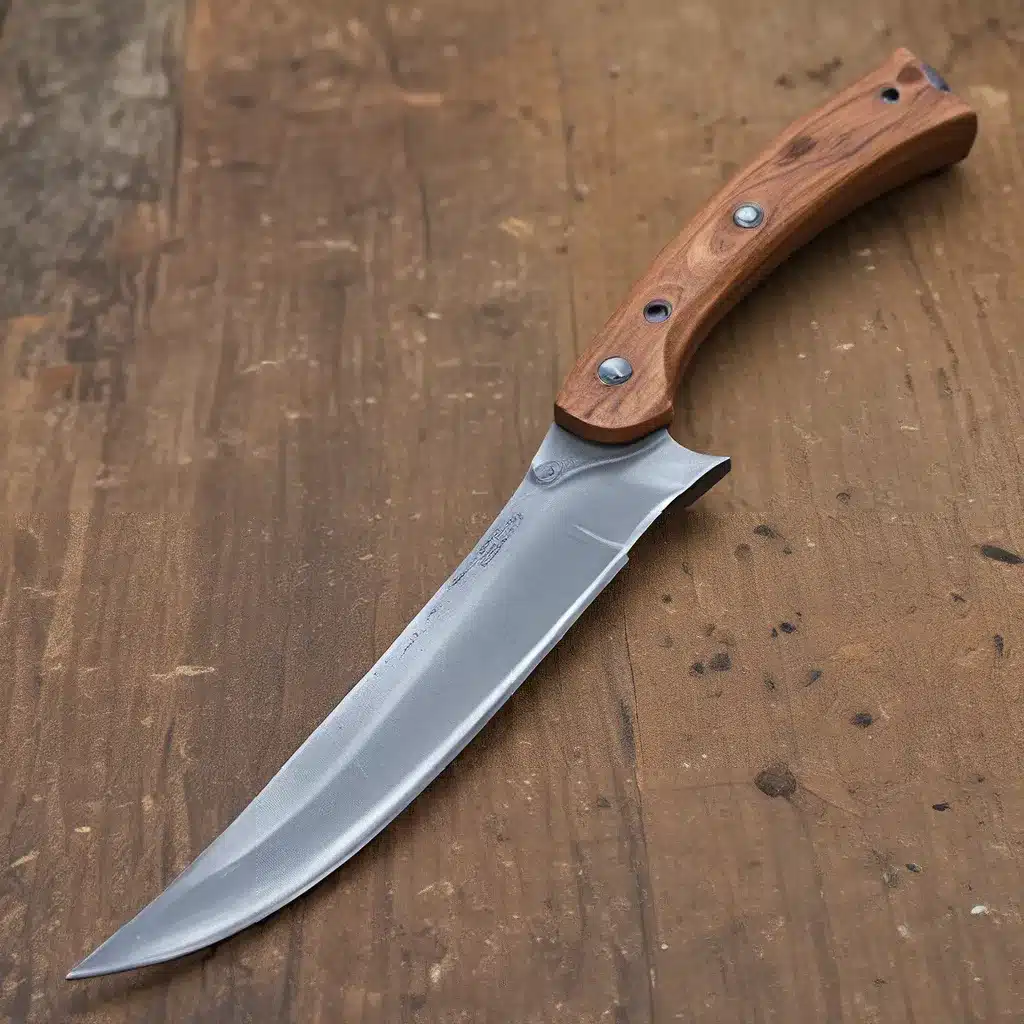
The Ancient Art of Bladesmithing
Ah, the allure of the forge – the hiss of hot steel meeting quenching oil, the rhythmic clanging of hammer on anvil. Forging a blade is a practice as old as humanity itself, a dance of fire, metal, and the sheer force of will. As I delve into the fundamentals of knife forging, I can’t help but feel a deep connection to the countless generations of artisans who have walked this path before me.
You see, the art of bladesmithing is rooted in thousands of years of history, spanning cultures and continents. From the earliest stone and bone tools to the ornate, pattern-welded swords of the Middle Ages, the evolution of blades has been a testament to human ingenuity and the pursuit of perfection. And while modern technology has certainly changed the landscape, the essence of this craft remains as captivating as ever.
Forging the Blade: A Delicate Dance
At the heart of knife forging lies a fundamental principle: control. Each step in the process – from selecting the right steel to meticulously shaping and tempering the blade – requires a deft touch and an unwavering focus. It’s a dance, really, where the smith must anticipate the metal’s every move and respond with precision.
Let’s start with the steel itself. Choosing the proper alloy is crucial, as different compositions react differently to heat and hammering. Some steels, like high-carbon varieties, are better suited for holding a keen edge, while others excel in toughness and flexibility. Mastering the art of reading the steel’s color and understanding its grain structure is a lifelong pursuit, but one that separates the skilled artisan from the novice.
Once the steel is selected, the real work begins. Heating the metal to the proper temperature – typically around 2,100 to 2,200 degrees Fahrenheit – is a delicate balancing act. Too hot, and the steel will become brittle; too cool, and it won’t respond to the hammering. The smith must develop a keen eye and a steady hand, shaping the blade with each strike of the hammer.
And let’s not forget the quenching process. This critical step, where the hot steel is plunged into a quenching oil, is what truly transforms the metal into a hardened, resilient blade. But the timing and technique here are paramount – a mere fraction of a second can mean the difference between a blade that holds its edge and one that shatters on the first use.
The Subtle Art of Finishing
But the forging process is only the beginning. Once the blade takes shape, the true artistry emerges in the finishing touches. Sanding, polishing, and sharpening the blade to a mirror-like sheen requires a level of patience and precision that few possess.
It’s here that the bladesmith’s woodworking skills come into play, as the construction of the handle is just as important as the blade itself. Selecting the right type of wood, shaping it to fit the user’s hand, and ensuring a secure, comfortable grip – these are the hallmarks of a truly masterful knife.
And let’s not forget the importance of the sheath. Crafting a durable, well-designed leather or kydex scabbard is the final touch that not only protects the blade but also reflects the overall aesthetic of the knife. It’s a delicate balance of form and function that separates the ordinary from the extraordinary.
The Crucible of Bladesmithing
As I delve deeper into the world of knife forging, I can’t help but be in awe of the dedicated artisans who have kept this ancient craft alive. Organizations like the American Bladesmith Society and schools like The Crucible have been instrumental in preserving and advancing the techniques of bladesmithing, offering aspiring smiths the opportunity to learn from the best in the business.
It’s in these crucibles of learning that the true magic happens. Under the watchful eye of seasoned mentors, students delve into the intricacies of forging, tempering, and sharpening, honing their skills until they can confidently forge a blade worthy of the name. And for those who truly embrace the challenge, the path to becoming a Master Bladesmith awaits, a testament to their dedication and mastery of this timeless art.
The Allure of Custom Knives
But the world of bladesmithing isn’t just about the pursuit of perfection – it’s also about the joy of creating something truly unique. And that’s where the appeal of custom knives comes into play.
Imagine holding a knife that was forged and crafted specifically for you, with every detail tailored to your preferences and needs. Whether it’s the shape of the blade, the texture of the handle, or the sheath that perfectly complements your style, a custom knife is a reflection of the user’s personality and the bladesmith’s artistry.
And for those who appreciate the value of high-quality, hand-crafted tools, a custom knife is a true investment in both form and function. It’s a blade that not only performs flawlessly but also becomes a cherished, heirloom-quality possession. Just imagine the stories it will one day tell, as it’s passed down through generations, each owner adding their own unique mark to its history.
Embracing the Journey
As I continue my own journey into the world of knife forging, I can’t help but feel a deep sense of excitement and anticipation. There’s something about the dance of fire, steel, and hammer that captures the imagination and sparks the creative spirit. And with each new challenge I face, I know I’m not just learning a skill – I’m connecting with a legacy that stretches back centuries, joining the ranks of the artisans who have dedicated their lives to this craft.
So if you’re feeling the pull of the forge, I encourage you to dive in and embrace the journey. Whether you’re a seasoned bladesmith or a complete novice, the path ahead is filled with endless possibilities. Who knows – you might just forge the next masterpiece that will captivate the hearts and imaginations of generations to come.


